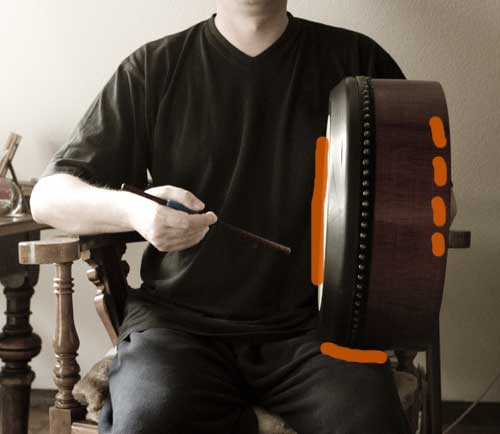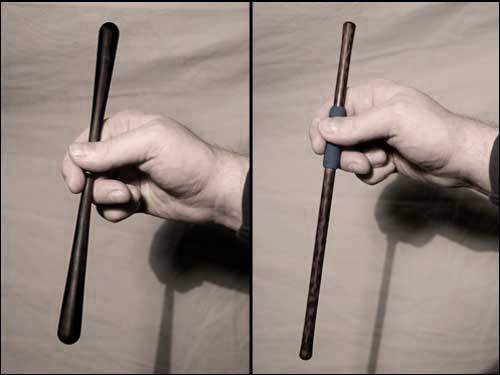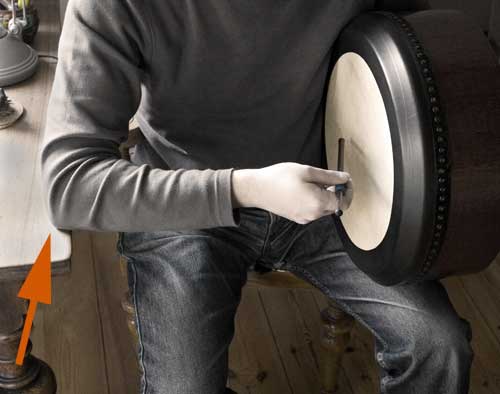How Do I Play?
On the couch Links, you can find a fair collection of good tutorials for beginning bodhrán players. Some pointers can also be found on the following pages of this site.
This tutorial is written for right-handed players. Left-handed players are kindly asked to do the analogy shuffle. This tutorial is also about the traditional Kerry Style, which seems to be the most wide-spread.
Holding the Bodhrán
The bodhrán is played while sitting. Also, the drum is struck sideways, not from above. To do this, the bodhrán is placed "upright" in a vertical position on your left thigh so that the skin of the drum is on the right side of the drum (from the player's POV). While the right hand is holding the tipper, the left hand reaches into the drum and gently comes to rest on the inner side of the skin. The drum should now be supported by the following four parts of your body:
- the left thigh (on which the instrument rests)
- the ribs on the left side of your body and
- the left lower arm, that gently presses the drum against your ribs
- the left hand on the skin

(NB: The photograph above only serves to illustrate how to hold the bodhrán. In no way is this a proper way to position the tipper arm to strike the drum. The tipper hand in the picture is in total resting mode and has nothing to do with playing.)
These four "supporting parts" of your body are marked in the photo above. You can also try to press against the frame with your shoulder so that the drum is supported from all sides.
Important: The "skin hand" and the arm do not really carry any weight of the drum while sitting. They need to be ready for action (such as movements on the inside of the skin, pressing the skin with the heel of the hand, etc.) in advanced play. The arm should not leave the outside edge of the frame, because othwerwise the drum will slip from your grip.
The thigh is not really necessary as a stabilization, as the drum can also be played standing (of course the arm and the "skin hand" do carry weight when playing while standing). It is much more comfortable to play while sitting, though.
One could say that the drum is almost tucked underneath the left arm. Of course avoid too much of the rib section pressing against the drum skin, lest the sound be excessively dampened. A little bit of the ribs pressing against the rim is OK. The crook of my left arm rests against the outside edge of the bodhrán.
Holding the Tipper
The tipper is held like a pen. Depending on playing style and tipper shape, you grip the stick either in the center (so that the center of rotation is in the middle) or in the upper third.

What would be the "tip" of the pen is called lower end of the tipper. The lower end is pointing towards the stomach/solar plexus of the player in the starting position: if the drum skin were a dial of a watch, the tipper as "watch hand" would point to nine o'clock. Also, your palm and the inside of your hand show up towards the ceiling. Moreover, you should be able to check whether you have clean fingernails in this position.
There are of course many other ways how to hold the tipper. With the Kerry Style, this is the most widely used, though.
Beating
For the first stroke, the lower end of the tipper moves downwards in a quarter circle from nine o'clock to six o'clock. While moving down, the head of the lower end also swerves towards the skin, makes contact with the skin at about 7.30 and then moves away from the skin again. The tipper end hits the skin sideways, by the way.
The whole movement is just like looking at a wrist watch on your right wrist. In other words, the rotating movement is executed only in the lower arm, merely ulna and radius (spoke bone and ell bone) rotate. The wrist remains relaxed, straight and is not bent, while the upper arm hardly moves at all.
This stroke is called a downstroke. The upper end of the tipper has no contact with the drum.
The next stroke is hence called an upstroke. To do this, the lower end of tipper moves from six o'clock back to nine o'clock. At the same time, the head of the lower end again swings towards the skin, strikes at about 7.30, before it again moves away from the skin. Once more, the upper end has no contact with the drum.
Important: What Is the Right Arm Doing?
Beginners usually allow for too much movement both with the hand as well as with the arm. The only permissible movement, though, is the described rotation of the wrist, as if looking at a wrist watch. The lower arm rotates (ulna and radius twist), and the upper arm is virtually still.
A good exercise to get a feel for keeping the right arm still while playing is to firmly lean the right elbow against the edge of a table, "fixing" the elbow there:

(NB: The picture shows how to position the elbow against the table edge for this exercise only, the sole purpose of which is to give a feel for keeping the right arm still during play. This is of course not an ideal arm position for regular play. The elbow of the arm holding the tipper is raised much too high in the picture because of leaning against the table edge. Normally, one plays the bodhrán without leaning against a table edge and thus with the arm /elbow positioned lower and closer to the body.)
Hitting the Skin
Sometimes, you may not succeed in hitting the skin with the tipper and instead may strike air. Here, it is helpful to mentally aim at a spot behind the skin. This little mind trick should really do it.
It might happen that your tipper is "scratching" over the skin. Again, the stroke is probably not powerful enough, because the distance between the skin and the tipper is not optimal. Perhaps the angle of the tipper towards the skin is too flat. Just try a steeper angle if that is the case.
From the very start, beginners should practice to always hit the same spot of the skin. This will help you control your strokes, especially when you later need to place strokes at specific locations. A good exercise to practice this is to hold a bottle of pop in a horizontal position and try to hit the bottle cap during your up- and downstrokes. Make sure to hit the top of the cap, not the bottle neck.
And the Left Hand?
The left hand usually rests gently against the inside of the skin while playing and thus softens the sound of your beats. If you leave your left hand off the skin, you get a deep, ringing bass, which some players really like. The problem is: others don't, and sooner or later, either your neighbors or the other musicians in your session will start to complain. Since there apparently are a lot of reckless bodhrán players out there, bodhránis have a somewhat tainted reputation in the session scene. While an occasional bass accent is perfectly fine, I would not recommend a permanent bass. So it is better to keep the left hand in place at the skin for most of the time.